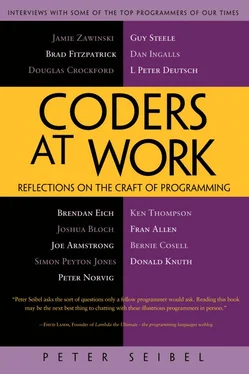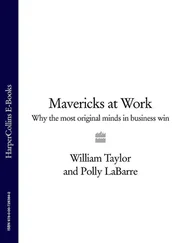Peter Seibel - Coders at Work - Reflections on the craft of programming
Здесь есть возможность читать онлайн «Peter Seibel - Coders at Work - Reflections on the craft of programming» весь текст электронной книги совершенно бесплатно (целиком полную версию без сокращений). В некоторых случаях можно слушать аудио, скачать через торрент в формате fb2 и присутствует краткое содержание. Жанр: Программирование, на английском языке. Описание произведения, (предисловие) а так же отзывы посетителей доступны на портале библиотеки ЛибКат.
- Название:Coders at Work: Reflections on the craft of programming
- Автор:
- Жанр:
- Год:неизвестен
- ISBN:нет данных
- Рейтинг книги:3 / 5. Голосов: 1
-
Избранное:Добавить в избранное
- Отзывы:
-
Ваша оценка:
- 60
- 1
- 2
- 3
- 4
- 5
Coders at Work: Reflections on the craft of programming: краткое содержание, описание и аннотация
Предлагаем к чтению аннотацию, описание, краткое содержание или предисловие (зависит от того, что написал сам автор книги «Coders at Work: Reflections on the craft of programming»). Если вы не нашли необходимую информацию о книге — напишите в комментариях, мы постараемся отыскать её.
Coders at Work
Founders at Work
Coders at Work: Reflections on the craft of programming — читать онлайн бесплатно полную книгу (весь текст) целиком
Ниже представлен текст книги, разбитый по страницам. Система сохранения места последней прочитанной страницы, позволяет с удобством читать онлайн бесплатно книгу «Coders at Work: Reflections on the craft of programming», без необходимости каждый раз заново искать на чём Вы остановились. Поставьте закладку, и сможете в любой момент перейти на страницу, на которой закончили чтение.
Интервал:
Закладка:
Seibel:This was basically brute-force search?
Thompson:Brute force.
Seibel:And so this was also in assembly probably?
Thompson:I have to think. Yeah, it was probably assembly. I can’t remember.
Seibel:You must have learned Fortran somewhere along the line.
Thompson:Yeah, well, I had to teach Fortran in the computer center and debug the Fortran programs. I never programmed in it. I wrote a Fortran compiler for Unix early, and B was an attempted Fortran compiler that got away from me.
Seibel:I thought B was your translation of BCPL.
Thompson:It sort of was. It started off as—I didn’t know what it was. Semantically, it turned out to be BCPL. As I started it, it was going to be Fortran. And at that point I got my first description of BCPL. And I liked the clean semantics. And that’s when I abandoned Fortran and it turned into essentially C syntax and BCPL semantics.
Seibel:Is there any really big differences in how you think about programming or how you practice programming from when you learned to now? Do you feel like your programming has matured in some way or you got better at it or you learned things that make you look back and say, “Oh, man, I didn’t know what I was doing back then.”?
Thompson:No, not really. Sometimes I look back at stuff I did and say, “Wow. I was much better then.” The period from when I spent that week reading that program to maybe when I was 30, 35 years old, I knew, in a deep sense, every line of code I ever wrote. I’d write a program during the day, and at night I’d sit there and walk through it line by line and find bugs. I’d go back the next day and, sure enough, it would be wrong.
Seibel:Do you think when you were 35 you could still remember the stuff you had written a decade before?
Thompson:Yes. Then I started being selective about what I’d remember.
Seibel:Is there anything you would have done differently about learning to program? Do you have any regrets about the sort of path you took or do you wish you had done anything earlier?
Thompson:Oh, sure, sure. In high school I wish I’d taken typing. I suffer from poor typing yet today, but who knew. I didn’t plan anything or do anything. I have no discipline. I did what I wanted to do next, period, all the time. If I had some foresight or planning or something, there are things, like typing, I would have done when I had the chance. I would have taken some deeper math because certainly I’ve run across things where I have to get help for math. So yeah, there are little things like that. But if I went back and had to do it over I’m sure that I just wouldn’t have it in me to do anything differently. Basically I planned nothing and I just took the next step. And if I had to do it over again, I’d just have taken the next step again.
Seibel:After school you got hired directly into the Bell Labs; how did that happen? It doesn’t sound like you were a classical academic researcher at that point in your career.
Thompson:I just drifted. It was hard to describe. I certainly wasn’t in school in any real sense. In the formal sense, yes, I was. One of my professors, who is actually a very good friend, sicced the Bell Labs recruiter on me. But I wasn’t looking for a job. In fact, I had absolutely no ambitions; nothing. And he made me appointments to see him in his little recruiting booth, and I either slept through them or told him I wasn’t interested. And he kept after me. At some point he called me and said that he wanted to come over and see me. So he came over to my apartment. And said that he wanted me to come out and interview at Bell Labs. I told him no. And he said, “It’s a free trip. You can do what you want to out there.” And I say, “Well, up front I’ll just tell you that I’m not interested in a job. I’ll be glad to go for a free trip ’cause I have friends on the East Coast. I’ll go visit them.” And he says, “Fine.” So that was the interview that I got into. And I went and spent my two days at Bell Labs and then rented a car and went up and down the East Coast visiting my high-school friends that were spread out all over everywhere.
Seibel:Obviously there was something that the folks at Bell Labs saw in you and said, “We should get this guy into our lab.”
Thompson:I don’t know their side of it. My side of it is that these are people that I was reading the papers of in the classes I was taking/teaching. And I knew them by name and reputation. And they were still doing fun things. To me, work was work and these guys weren’t working. They were having a good time. Just like school.
Seibel:And so what kind of things did you do when you first arrived there?
Thompson:Bell Labs was in the MULTICS project and I was hired in to work on MULTICS. And I did. I played with the machines, booted up MULTICS, and did my little piece of it. At some point, Bell Labs decided that MULTICS wasn’t for them, and they backed out of the project.
But they had these MULTICS machines which were special-purpose machines that were just sitting around idle until someone could cart them away. So for approximately a year I had this machine that was monstrous. There are maybe two or three of us that used it. So I started doing operating-system stuff, trying to get a little operating system up and running.
It was insanely hard because it was a real complex computer. But I got it up where it would sit there and say hello on 50 Teletypes around the building. And then it went out the door. So I shopped around then and found some other unused machines and essentially built Unix on these very, very small PDP machines.
Seibel:Did you have the time to do that because your bosses knew that that’s what you were doing and said this is a good research project, or was it just because you were in between jobs?
Thompson:No, I was sort of incorrigible, to be honest. I suspected that I would eventually get fired, but it didn’t bother me. We were supposed to be doing basic research but there was some basic research we should be doing and some basic research we shouldn’t be doing. And just coming out of the ashes of MULTICS, operating systems was one of those basic research things we shouldn’t be doing. Because we tried it, it didn’t work, it was a huge failure, it was expensive; let’s drop it. So I kind of expected that for what I was doing I was going to eventually get fired. I didn’t.
Seibel:How do you design software? Do you scribble on graph paper or fire up a UML tool or just start coding?
Thompson:Depends on how big it is. Most of the time, it sits in the back of my mind—nothing on paper—for a period of time and I’ll concentrate on the hard parts. The easy parts just fade away—just write ’em down; they’ll come right out of your fingertips when you’re ready. But the hard parts I’ll sit and let it germinate for a period of time, a month maybe. At some point pieces will start dropping out at the bottom and I can see the pyramid build up out of the pieces. When the pyramid gets high enough in my mind, then I’ll start at the bottom.
Seibel:But you’re not just building leaves—you know the structure they’re going to fit into.
Thompson:Suppose someone is describing something to me from postulates like, “Here’s a computer and here are the op codes.” I can visualize the structure of programs and how things are efficient or inefficient based on those op codes, by seeing the bottom and imagining the hierarchy. And I can see the same thing with programs. If someone shows me library routines or basic bottom-level things, I can see how you can build that into different programs and what’s missing—the kinds of programs that would still be hard to write. So I can envision that pyramid, and the problem is to try and decompose it and get the bottom pieces.
Читать дальшеИнтервал:
Закладка:
Похожие книги на «Coders at Work: Reflections on the craft of programming»
Представляем Вашему вниманию похожие книги на «Coders at Work: Reflections on the craft of programming» списком для выбора. Мы отобрали схожую по названию и смыслу литературу в надежде предоставить читателям больше вариантов отыскать новые, интересные, ещё непрочитанные произведения.
Обсуждение, отзывы о книге «Coders at Work: Reflections on the craft of programming» и просто собственные мнения читателей. Оставьте ваши комментарии, напишите, что Вы думаете о произведении, его смысле или главных героях. Укажите что конкретно понравилось, а что нет, и почему Вы так считаете.












